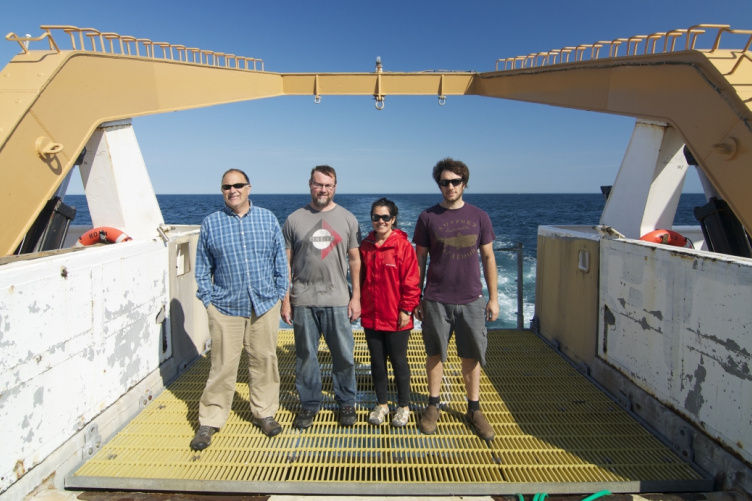
From left to right, the UNH crew aboard NOAA’s R/V Gordon Gunter: cruise chief scientist Joe Salisbury, research scientist Shawn Shellito, Ph.D. student Melissa Meléndez Oyola and research scientist Marc Emond.
Led by UNH biogeochemical oceanographer Joe Salisbury, a group of 15 scientists is currently aboard the National Oceanic and Atmospheric Administration research vessel Gordon Gunter on a two-leg, 34-day expedition that will help determine how humans are causing changes in the oxygen and carbon dioxide content of oceans, leading to the global acidification of seawater.

Ocean acidification, or the progressive decline of seawater pH over decades, has potentially devastating ramifications for all ocean life — from the smallest, single-celled algae to the largest whales. For example, shellfish larvae, including those of clams, mussels and scallops, begin their lives in shallow coastal waters where they must begin building their protective shells immediately. They do so by pulling calcium carbonate out of seawater. But as seawater becomes more acidic, the critical ingredient is in shorter supply.
The East Coast Ocean Acidification cruise, funded by NOAA’s Ocean Acidification Program and covering maritime waters from Canada to Florida, is the third in a series of such hydrographic surveys conducted every four to five years in an effort to understand long-term changes to the ocean’s chemistry in a vast swath of the coastal zone. Among other things, this knowledge can help scientists determine what’s causing the warming or cooling of the oceans as well as the transport of ocean waters from one place to another around the world.
Salisbury, of the UNH Institute for the Study of Earth, Oceans, and Space’sOcean Process and Analysis Laboratory, or OPAL, is the chief scientist for the cruise and is joined by OPAL research scientists Shawn Shellito, Marc Emond and Ph.D. student Melissa Meléndez Oyola. Also participating are scientists from five other institutions — University of Delaware, University of Massachusetts, Miami University, Princeton and Old Dominion, as well as NOAA’s Atlantic Oceanographic and Meteorological Laboratory. The cruise will also involve coordinated efforts with the Environmental Protection Agency and NASA.
The ocean-going researchers work 24 hours a day collecting samples, taking high-precision measurements and analyzing seawater carbonate (a mix of carbon compounds and ions) chemistry, biogeochemical processes and optical properties. This ambitious mission covers areas that have never been measured before using a series of new techniques and sensors.
It is one of a very few research expeditions aimed solely at characterizing coastal seawater carbonate chemistry and all of the biogeochemical factors that contribute to it. This is the first time that scientists will get an in-depth view of the waters in the Gulf of Maine. Understanding the chemistry of water on the Scotian Shelf southwest of Nova Scotia is critical for scientists to understand how ocean acidification might unfold in the Gulf of Maine.
Notes Salisbury, “About 10 years ago we started realizing that there’s a lot of economic activity in the coastal zone that could be harmed by climate change and ocean acidification, and we really don’t have a set of coherent measurements for this coastal, inshore zone compared to deeper waters offshore. So these cruises are extremely valuable and necessary scientific endeavors.”

















































